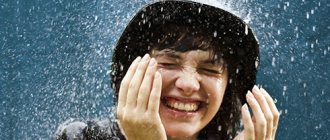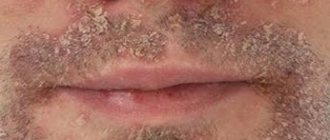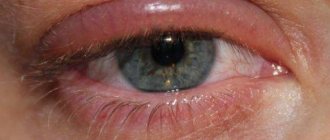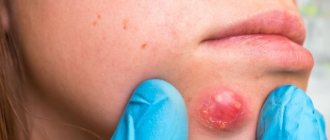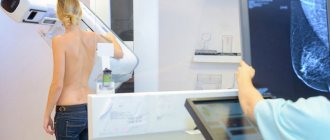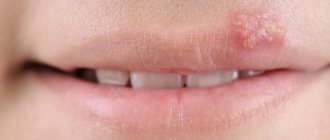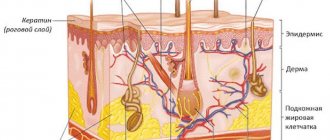One of the patients, a French teacher, told the following story: “At the beginning of her career, she was asked to help a little with translation for a Swiss journalist who flew to St. Petersburg on business. During their first meeting, the Swiss immediately asked if she knew the technique of simultaneous translation. The girl answered in the negative and decided that the interview was over, but the employer surprised her by saying that it no longer mattered, and in an hour they should be in the mayor’s reception room. At the moment of this strong experience, she accidentally saw her reflection in the mirror. The picture was frightening: the whole face and neck were covered with bright red spots, which were miraculously set off by the purple dress. For the rest of the time, she was no longer worried about how she would cope with simultaneous translation, but whether she would have time to turn pale.”
Fortunately, the story ended positively in every sense, but how many unpleasant moments can untimely vessels cause?
Skin health is largely a matter of vascular health. The physiological supply of nutrients to the skin and the normal course of thermoregulation processes are possible only with adequate functioning of the microvasculature. Normally, microcirculation is provided by the arteriolar choroid plexus (subpapillary - located on the border of the papillary and reticular layers of the dermis and subdermal - located on the border of the dermis and subcutaneous fatty tissue) and the superficial and deep venular choroid plexus.
Thermoregulation is provided by deeper vessels: mainly subcutaneous arterial and larger venous plexuses.
A number of exogenous and endogenous factors can have a damaging effect on the vascular wall:
- Hormonal and neurogenic factors
- Sharp fluctuations in high and low temperatures
- Mechanical skin damage
- Digestive diseases
- Ultraviolet irradiation
Let us consider the mechanisms of action of the most significant factors in a little more detail.
Hormonal and neurogenic factors
Estrogens influence the sympathetic nervous system by acting on 2-adrenergic receptors, which leads to vasospastic reactions. Starting from a certain age (about fifty years), the production of estrogens and progesterones decreases in the female body. This condition is very often accompanied by a feeling of heat, temporary, sometimes long-lasting facial hyperemia.
In general, vasospastic diseases and reactions (Raynaud's phenomenon) are more common in women and are more common during the reproductive period. During pregnancy, a decrease in the vasospastic readiness of facial skin vessels is often observed. Microcirculation in the facial skin varies throughout the menstrual cycle.
Solving the problem yourself
Temporary, or transient, redness of the facial skin is not considered a pathology. It disappears on its own and does not cause much discomfort other than psychological. To remove occasional cases of hyperemia on your own, you should follow simple steps:
- Remove the irritating factor
. Change the environment, wash off the allergen or toxic substance from the surface of the skin, try to calm down. - Restore natural skin color
. Folk remedies and herbal remedies help with this. You must first make sure that you are not allergic to the components. - Take care to strengthen the protective barrier
. To do this, it is advisable to carry out a set of measures aimed at improving the health of the body as a whole and maintaining the functional properties of the skin.
The following recommendations can also help get rid of a red face, but will require a long time and lifestyle adjustments.
Gentle cleansing and care.
You should wash your face with warm water, without contrasting temperatures, and dry with a soft towel with light blotting movements.
Prevention of infections.
An important rule is to never touch your face with your hands unnecessarily. The habit of removing pimples yourself can lead to infection not only local, but also general. Even with minor damage and scratches, it is worth immediately treating the area of microtrauma with an aseptic substance.
Lifestyle.
The diet must contain foods rich in fiber and vitamins.
It is worth avoiding the consumption of salty foods, smoked meats, spicy seasonings and alcohol. Good sleep and a calm microclimate also help remove redness on the face. Caring cosmetics.
The beauty industry provides a wide range of cleansing, lipid-restoring and healing products. It can be difficult to understand them on your own, however, dermatologists recommend not to get carried away with cosmetics based on alcohol solutions and to carefully choose them. Individual consultation
Sharp fluctuations in high and low temperatures
The effect of cold on the condition of blood vessels should not be underestimated - the first reaction to a decrease in temperature is a sharp vasospasm in order to reduce heat transfer. Subtle mechanisms of autonomic regulation are activated, followed by compensatory vasodilation.
Many clinical symptoms of prerosacea and rosacea develop through this mechanism.
The autonomic nervous system has both direct and indirect effects on the microvasculature. Normally, the vasoconstrictor effect is exerted by norepinephrine, which acts on alpha-1 adrenergic receptors; vasodilator - adrenaline acting on beta-2 adrenergic receptors of smooth muscle cells of arterioles.
The production of acetylcholine is accompanied by dilation of the vessel and an increase in the speed of blood flow in it (due to stimulation of NO production through M receptors). This vascular response is called endothelium-dependent dilation. A mechanism of endothelium-dependent vasoconstriction associated with the synthesis of endothelin-1 and 20-HETE in the endothelium is also identified.
Autonomic dysfunctions contribute to disruption of homeostasis and adaptation of the body to various environmental influences and lead to disruption of the skin structure, increased permeability of the vascular wall, decreased barrier functions of the epidermis and create conditions for the development of inflammation in the skin.
Many clinical symptoms of prerosacea and rosacea develop through this mechanism.
Diagnosis of hyperemia
Red facial skin can be both a protective reaction to irritants and a signal of disturbances in the human body. Timely diagnosis and treatment help delay the development of serious pathologies. Studying the problem begins with collecting complaints and medical history. Thus, episodes of skin color changes should be carefully analyzed.
If the redness on the face is of a short-term local nature, has a clear connection with any cause, goes away on its own after it is eliminated and is not accompanied by other symptoms, then a person can cope with the change in skin color without outside help.
In cases of systematic red spots on the face, the causes of which are unclear, the help of a specialist is necessary. The reason to urgently contact him is the simultaneous combination of redness on the face and peeling, itching, burning, microcracks, as well as general weakness, fatigue and disruption of the internal organs.
In such cases, laboratory tests of blood and urine, available instrumental studies of the cardiovascular system (measurement of blood pressure and pulse, ECG and assessment of the condition of blood vessels) are performed. Taking into account preliminary data, the doctor may prescribe dermatological and allergological tests, determination of the hormonal profile, and in-depth instrumental procedures (radiography, ultrasound, MRI, CT).
Modern laboratory and instrumental equipment will provide the opportunity for comprehensive general clinical observation, and the joint work of several specialists will make it possible to more accurately determine the nature of facial redness and its causes.
Digestive diseases
Diseases of the gastrointestinal tract can indirectly affect vascular health. Irritation from the mucous membrane of the gastrointestinal tract is transmitted through the branches of the vagus nerve to its nuclei, the excitation passes to the nearby nuclei of the trigeminal nerve and through the branches of the latter enters the central zone of the face, causing vasodilation.
Recent studies confirm that the bacteria Helycobacter pylori persisting in the gastric mucosa contributes to the disruption of neurochemical regulatory mechanisms, which in turn lead to vasodilation.
Reasons are physiological
These include:
- cold wind;
- severe frost;
- high air temperature;
- exposure to direct sunlight;
- alcohol abuse;
- high physical activity;
- heavy loads at work;
- the use of cosmetics that irritate the skin, for men - creams, shaving lotions;
- poor night sleep;
- nervous overstrain;
- stressful situations;
- depression.
Redness quickly reaches its maximum, after which it disappears, leaving no consequences.
Ultraviolet irradiation
The sun is life! We know how important vitamin D is for beauty and health, but we must not forget about the harmful effects of ultraviolet rays.
In particular, it was found that 50% of UVA rays penetrate the skin to the papillary and reticular layers. They damage the endothelial cells of blood vessels and the basement membrane of the lymphatic microvessels of the skin, which leads to disruption of blood outflow.
As a result of adverse environmental influences and violations of internal regulatory mechanisms, the number of patients suffering from disorders of skin microcirculation is increasing - seeking help as cosmetic defects develop.
We are faced with the task of increasing the tone of the vascular walls and restoring their structure, eliminating the signs of sensitive skin (erythematous-squamous spots, rosacea, angioneurosis) and the associated discomfort.
As a result of adverse environmental influences and violations of internal regulatory mechanisms, the number of patients suffering from skin microcirculation disorders is increasing.
Especially to solve these problems, ]Pevonia Botanica[/anchor] has developed a line of RS2 products for very sensitive skin with microcirculation disorders.
Main active ingredient : licorice extract
, contains 18-beta-glycerrisic acid.
The medicinal properties of licorice were known long before the discovery of its component composition; modern scientific research has proven that glycyrrhizic acid is a unique natural compound with anti-inflammatory, reparative and vasoconstrictor effects. The composition also includes green tea, incense, B vitamins and microelements - all together this has a prolonged restorative effect on the structure of the vascular wall, strengthening blood vessels, reducing the manifestations of rosacea and congestion.
What causes skin redness during rosacea?
Manifestations of rosacea increase with vascular and immune disorders, gastrointestinal dysfunction, exposure to climatic factors, and emotional stress. The course of rosacea is aggravated by cosmetics and cleansers that have an irritating effect (waterproof cosmetics and toning preparations, the removal of which requires the use of solvents, as well as cleansers containing soap). Therefore, the basis of daily skin care for rosacea is recommended:
- gentle skin cleansing
- supporting the natural balance of healthy skin microflora
- moisturizing and protecting the skin from the sun
- control of dilated vessels.
Recommended masks to relieve facial redness
It is recommended to use the proposed masks for at least 14 days for them to be effective.
- Oatmeal mask . Pour 2 tbsp. cereal 6 tbsp. hot water, let it brew for 20 minutes, then stir. It is better to apply the mixture in a thick layer on the face.
- Kefir-curd mask . 2 tbsp. Add high-fat cottage cheese with kefir and mix thoroughly until it reaches a creamy consistency. Instead of kefir, you can use sour cream if your skin type is dry or redness is the result of peeling.
- Curd and carrot mask . Grind the carrots on a grater. Mix and apply to face.
- Cucumber mask . Finely grate the cucumber and apply to the face.
- Potato mask . Potatoes can be used boiled or raw. It should be grated and squeezed out the juice.
- Banana mask. Mash the banana to a paste and apply to your face.
- Sour cream mask with honey . Honey contains many vitamins and beneficial microelements, and sour cream is effective in removing redness from dry, flaky skin.
- Egg and aloe mask. This mask perfectly eliminates inflammation and relieves redness.
Rosacea. Why is my face red?
Health topics hypertension
General tips for dealing with facial redness
If your face has changed color, you can deal with it quickly enough if the reason is minor. The main recommendations in such situations are:
- control over emotions - you can drink a sedative, for example, valerian tincture;
- change in diet - spicy foods and seasonings should be excluded;
- do not drink alcohol, which promotes vasodilation;
- no smoking;
- replace medications;
- do not use expired cosmetics;
- be tested for allergens;
- take vitamins;
- strengthen the body and increase immunity;
- do not use a solarium;
- do not use paraffin-based masks;
- refuse massage.
Facial redness can be caused by the autoimmune disease lupus erythematosus . Redness occurs due to a malfunction in the immune system. A rash forms on the face, causing a burning sensation on the face.

